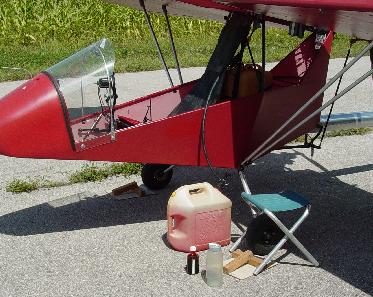 I find refueling the FireFly easier to do sitting down. I use a little hand operated fuel transfer pump. The other components are a sloshing bottle and a oil measuring bottle.
I find refueling the FireFly easier to do sitting down. I use a little hand operated fuel transfer pump. The other components are a sloshing bottle and a oil measuring bottle.
During the refueling process I place the FireFly gas tank cap on the seat cushion. I evolved to this when one day I taxied away after topping the tank. When I turned to taxi down wind I could smell gas. I had placed the cap on the back side of the tank and had not screwed it on.
|
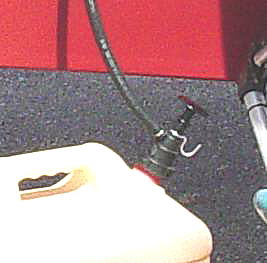 This is a better look at the top end of the transfer pump. A short hose attaches to the bottom so that it can remove gas down to the tank bottom. A longer hose is attached to the top to reach the FireFly gas tank. I found this little pump in a farm equipment store (Tractor Supply). The pump is "Han-D-Pump, Model#: HP009." It weighs very little.
This is a better look at the top end of the transfer pump. A short hose attaches to the bottom so that it can remove gas down to the tank bottom. A longer hose is attached to the top to reach the FireFly gas tank. I found this little pump in a farm equipment store (Tractor Supply). The pump is "Han-D-Pump, Model#: HP009." It weighs very little.
At this time I have 83 hours on the FireFly. Assuming an average of 2.5 gph, it calculates out to about 208 gallons this pump has transfered. The piston rod gland seal adjustment is completely compressed. I will have to add some additional packing to keep it from leaking a round the rod. Other wise it is working fine.
|
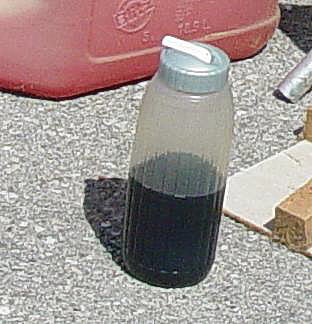 The amount oil required to mix with the gas to be added to the tank is poured into the measuring bottle and then transferred to the sloshing bottle. The transfer pump is used to fill the sloshing bottle half full with gasoline. The top is screwed on the bottle and the mixture shaken until it is thoroughly mixed. The top is removed and the mixture poured in the FireFly gas tank. The sloshing bottle is a Walmart drink bottle. A convenient place to hold the upper end of the transfer hose is to wedge it in between the struts next to the fuselage.
The amount oil required to mix with the gas to be added to the tank is poured into the measuring bottle and then transferred to the sloshing bottle. The transfer pump is used to fill the sloshing bottle half full with gasoline. The top is screwed on the bottle and the mixture shaken until it is thoroughly mixed. The top is removed and the mixture poured in the FireFly gas tank. The sloshing bottle is a Walmart drink bottle. A convenient place to hold the upper end of the transfer hose is to wedge it in between the struts next to the fuselage.
|
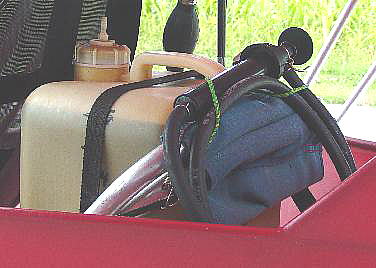 The folded camp stool goes over the fuel tank with the coiled transfer pump on top and the whole works held in place with two bungee cords. The oil and oil measuring and sloshing bottles are placed in one of the luggage compartments.
The folded camp stool goes over the fuel tank with the coiled transfer pump on top and the whole works held in place with two bungee cords. The oil and oil measuring and sloshing bottles are placed in one of the luggage compartments.
A barb pipe coupling was inserted in the lower end of the tubing that goes into the fuel transfer tank. The barbs on the free end were ground down so that it would slip into the fuel output end of the hose with just enough force so that it would stay coiled. This keeps contaminates out from inside the system.
|
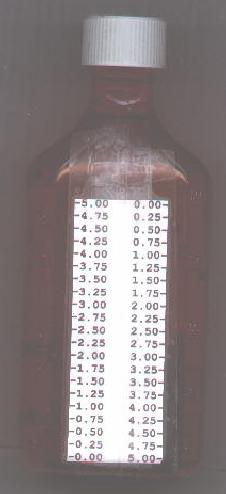 At first, I used one scale on my oil measuring bottle, the one on the left and it corresponds to the scale on the tank. I had to calculate what was the correct amount of oil to put into the bottle to mix with gas for the unfilled portion of the tank. To get around this, I placed a second inverted scale on the bottle. I read how much fuel is in the tank and I pour the corresponding amount oil into the bottle to match the right hand inverted scale and it automatically gives me the correct amount of oil for the unfilled portion of the tank.
At first, I used one scale on my oil measuring bottle, the one on the left and it corresponds to the scale on the tank. I had to calculate what was the correct amount of oil to put into the bottle to mix with gas for the unfilled portion of the tank. To get around this, I placed a second inverted scale on the bottle. I read how much fuel is in the tank and I pour the corresponding amount oil into the bottle to match the right hand inverted scale and it automatically gives me the correct amount of oil for the unfilled portion of the tank.
The oil measuring bottle is an eight ounce medicine bottle I found at the local drug store. It works well for mixing at a 100 to 1 ratio. If you would like a copy of the scale that fits the bottle just click here and download a Microsoft Word word processor file.
The medicine bottle comes with a kid proof cap. The oil will make it very diffucult to remove the cap. To get around this problem, one can carefully pop off the white outer portion of the cap, put some epoxy inside and snap it back into place. It makes it much easier to open the bottle.
|
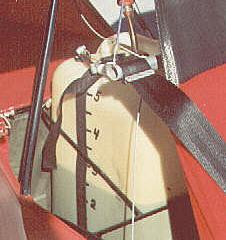 The tank has been marked off in full and half gallons. It is very easy to estimate the quarter gallons, etc. Most refueling aprons are fairly level, so what one reads on the tank is quite accurate. With the scale marked up and down in the middle of the tank side wall also ensures that you are getting an accurate fuel reading.
Fuel Tank Scale Update
The tank has been marked off in full and half gallons. It is very easy to estimate the quarter gallons, etc. Most refueling aprons are fairly level, so what one reads on the tank is quite accurate. With the scale marked up and down in the middle of the tank side wall also ensures that you are getting an accurate fuel reading.
Fuel Tank Scale Update
A new fuel tank scale can be seen here.
|
Refueling Up Date - July 23, 2003
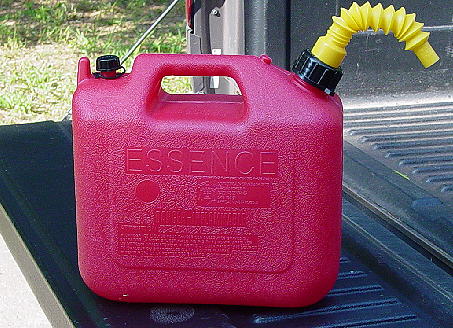 I am having trouble lifting full five gallon gasoline containers. I was looking for something smaller when I spied this little 2.5 gallon gas can in the hardware store. I bought one to try. The most pleasant surprise was the spout. It adjusts so one can pour gas into the FireFly tank with out a funnel.
I am having trouble lifting full five gallon gasoline containers. I was looking for something smaller when I spied this little 2.5 gallon gas can in the hardware store. I bought one to try. The most pleasant surprise was the spout. It adjusts so one can pour gas into the FireFly tank with out a funnel.
Another advantage is that with such a small can, one can pour the oil into the can, put a little gas in, and slosh the mixture in the can. This gets rid of the slosh bottle and the transfer pump that I have been using. Also, by premixing, one mixes the same amount of oil every time and one needs only one mark on the oil measuring bottle. I will continue to carry the camp stool to let me rest my bones while on the ground.
|